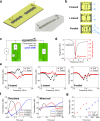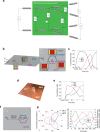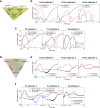Pulse-driven self-reconfigurable meta-antennas
- PMID: 36746941
- PMCID: PMC9902461
- DOI: 10.1038/s41467-023-36342-1
Pulse-driven self-reconfigurable meta-antennas
Abstract
Wireless communications and sensing have notably advanced thanks to the recent developments in both software and hardware. Although various modulation schemes have been proposed to efficiently use the limited frequency resources by exploiting several degrees of freedom, antenna performance is essentially governed by frequency only. Here, we present an antenna design concept based on metasurfaces to manipulate antenna performances in response to the time width of electromagnetic pulses. We numerically and experimentally show that by using a proper set of spatially arranged metasurfaces loaded with lumped circuits, ordinary omnidirectional antennas can be reconfigured by the incident pulse width to exhibit directional characteristics varying over hundreds of milliseconds or billions of cycles, far beyond conventional performance. We demonstrate that the proposed concept can be applied for sensing, selective reception under simultaneous incidence and mutual communications as the first step to expand existing frequency resources based on pulse width.
© 2023. The Author(s).
Conflict of interest statement
The authors declare no competing interests.
Figures






References
-
- Dang S, Amin O, Shihada B, Alouini M-S. What should 6G be? Nat. Electron. 2020;3:20–29.
-
- Al-Fuqaha A, et al. Internet of things: A survey on enabling technologies, protocols, and applications. IEEE Commun. Surv. Tutor. 2015;17:2347–2376.
-
- Electronic Communications Committee. The European Table of Frequency Allocations And Applications in The Frequency Range 8.3 KHz to 3000 GHz (ECA TABLE). in Proceedings of European Conference of Postal and Telecommunications Administrations (Electronic Communications Committee, 2020).
-
- Federal Communications Commission, United States of America. FCC ONLINE TABLE OF FREQUENCY ALLOCATIONS 47 C.F.R. § 2.106, Revised on July 1, https://transition.fcc.gov/oet/spectrum/table/fcctable.pdf (2022).
-
- The Ministry of Internal Affairs and Communications (MIC) Japan. MIC Frequency Assignment Plan, September 2021, https://www.tele.soumu.go.jp/e/adm/freq/search/share/plan.htm (2021).
Grants and funding
- JPMJPR193A/MEXT | JST | Precursory Research for Embryonic Science and Technology (PRESTO)
- JPMJPR193A/MEXT | JST | Precursory Research for Embryonic Science and Technology (PRESTO)
- 17KK0114/MEXT | Japan Society for the Promotion of Science (JSPS)
- 21H01324/MEXT | Japan Society for the Promotion of Science (JSPS)
LinkOut - more resources
Full Text Sources

